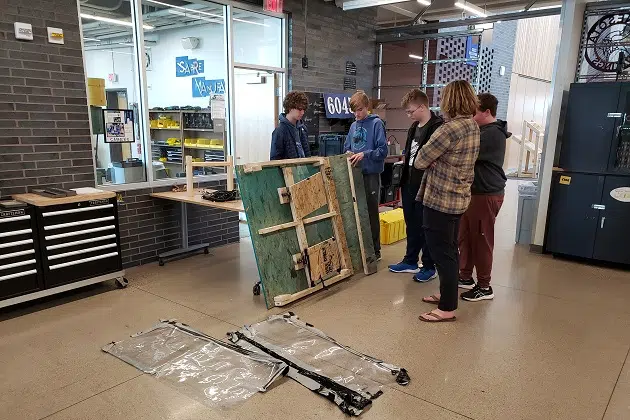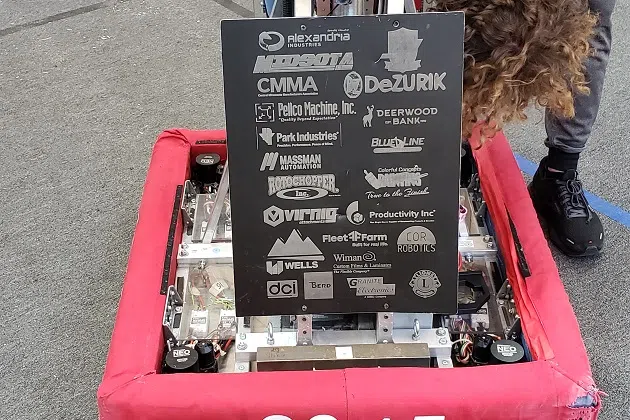(KNSI) – The Sartell Robotics team has only had since January to build their entrant for this year’s competition but has quickly put together a potential world champion machine.
Head Coach Ryan Swanson says each squad receives an 80-page instruction manual from FIRST Robotics near the beginning of the year with a description of the challenge.
“And the first impression that I had on the new game was it’s a game that really heavily depends on driver skill and programming ability. And so, we built a really simple mechanical robot that we could get done early and we give a lot of time to our programmers and we could get a lot of driver practice.”
The group of roughly 20 people had to design a robot that can pick up objects like cubes and traffic cones and then drop them off on a multilevel platform on the other end of the playing floor.
One of the primary builders on the team is sophomore Paige Erickson. She says one night after the game rules were released, members started making prototypes from wood and random materials. When they had a design, they began to cut their pieces, which took a couple of weeks. Ever since they have been tinkering in the quest to optimize performance.

The builders make adjustments to one of the practice course. The replica playing field is used after school in preparation for the FIRST Robotics world championship in Houston. Grant Dossetto/KNSI News
To excel in FIRST Robotics, a team must have a machine that can operate by itself and then under human control. The first 15 seconds of each competition involves the robot zipping through the course autonomously. Swanson says his squad prides itself on getting out to a good start.
“Our autonomous mode can score three game objects in that 15-second period and that is [a] top 10 autonomous mode in the world. And it’s currently the best in Minnesota.”

A regional championship banner hangs in the halls of Sartell High School. Grant Dossetto/KNSI News
Sartell will travel to Houston in two weeks to compete against roughly 600 other teams from across the globe. The squads are separated into eight divisions through a random draw. The top three in each division advance to the final bracket to determine a world champion.
“The Bismarck” is, by their admission, a simple mechanical machine. It has a chassis, drive train, mechanical arm, and then a grabber with spinning wheels that act as suction for the various objects it has to pick up. The arm and grabber are powered by only four motors. Lead programmer Isaac Patton says the coding side of things is more complex.
“In terms of programming, for the team, it’s probably somewhere between 350 and 400 hours so far in like the last two months. I’d say there’s probably somewhere around 4,000 lines of code that we’ve written.”
The robot must be able to operate on its own, using Java code that divides the playing surface into a coordinate system. Once the team members take the machine under their control, they use two modified Xbox controllers. One drives the robot and the other gives it commands to do its pick ups.
Build lead Tyler Clauson will have one of those controllers. He talks about how it works.
“Something Isaac has done this year, that’s really great…You can tell the robot to put the arm at a certain angle or, like, height. And then what we can do with that is determine set points for scoring at each level of the grid, and then also a set point for intaking. So it’s probably 12 buttons or something I have to know on that controller so that I can go to every position that we need.”
The driver is Seth Westrup. He was one of three team members who sat down with KNSI and said they plan on attending college for some combination of computer science and engineering disciplines.
Captain Josh Bruemmer is in his fourth year as part of the robotics team. He has transitioned to the business side of things. The Sartell-St. Stephen School District gives the group $6,000 to register for the regional rounds of FIRST Robotics. “The Bismarck” costs between $12,000 and $18,000. Bruemmer has been involved with fundraising to ensure that a machine could actually get built. Traveling to Houston comes with costs of its own.

A list of corporate sponsors that make the robot possible. Grant Dossetto/KNSI News
He talks about going to individual partner companies and the Chamber of Commerce to present. They also serve concessions at Sartell High School sporting events and other performances. Bruemmer says he hopes to use what he has learned about the whole process to become a technical education instructor in the future.
___
Copyright 2023 Leighton Enterprises, Inc. All rights reserved. This material may not be broadcast, published, redistributed, or rewritten, in any way without consent.










